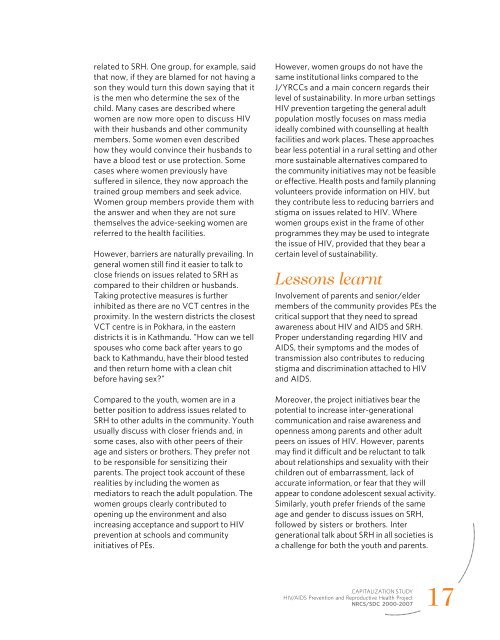HIV/AIDS Prevention & Reproductive Health Project
HIV/AIDS Prevention & Reproductive Health Project
HIV/AIDS Prevention & Reproductive Health Project
Create successful ePaper yourself
Turn your PDF publications into a flip-book with our unique Google optimized e-Paper software.
elated to SRH. One group, for example, said<br />
that now, if they are blamed for not having a<br />
son they would turn this down saying that it<br />
is the men who determine the sex of the<br />
child. Many cases are described where<br />
women are now more open to discuss <strong>HIV</strong><br />
with their husbands and other community<br />
members. Some women even described<br />
how they would convince their husbands to<br />
have a blood test or use protection. Some<br />
cases where women previously have<br />
suffered in silence, they now approach the<br />
trained group members and seek advice.<br />
Women group members provide them with<br />
the answer and when they are not sure<br />
themselves the advice-seeking women are<br />
referred to the health facilities.<br />
However, barriers are naturally prevailing. In<br />
general women still find it easier to talk to<br />
close friends on issues related to SRH as<br />
compared to their children or husbands.<br />
Taking protective measures is further<br />
inhibited as there are no VCT centres in the<br />
proximity. In the western districts the closest<br />
VCT centre is in Pokhara, in the eastern<br />
districts it is in Kathmandu. "How can we tell<br />
spouses who come back after years to go<br />
back to Kathmandu, have their blood tested<br />
and then return home with a clean chit<br />
before having sex?"<br />
Compared to the youth, women are in a<br />
better position to address issues related to<br />
SRH to other adults in the community. Youth<br />
usually discuss with closer friends and, in<br />
some cases, also with other peers of their<br />
age and sisters or brothers. They prefer not<br />
to be responsible for sensitizing their<br />
parents. The project took account of these<br />
realities by including the women as<br />
mediators to reach the adult population. The<br />
women groups clearly contributed to<br />
opening up the environment and also<br />
increasing acceptance and support to <strong>HIV</strong><br />
prevention at schools and community<br />
initiatives of PEs.<br />
However, women groups do not have the<br />
same institutional links compared to the<br />
J/YRCCs and a main concern regards their<br />
level of sustainability. In more urban settings<br />
<strong>HIV</strong> prevention targeting the general adult<br />
population mostly focuses on mass media<br />
ideally combined with counselling at health<br />
facilities and work places. These approaches<br />
bear less potential in a rural setting and other<br />
more sustainable alternatives compared to<br />
the community initiatives may not be feasible<br />
or effective. <strong>Health</strong> posts and family planning<br />
volunteers provide information on <strong>HIV</strong>, but<br />
they contribute less to reducing barriers and<br />
stigma on issues related to <strong>HIV</strong>. Where<br />
women groups exist in the frame of other<br />
programmes they may be used to integrate<br />
the issue of <strong>HIV</strong>, provided that they bear a<br />
certain level of sustainability.<br />
Lessons learnt<br />
Involvement of parents and senior/elder<br />
members of the community provides PEs the<br />
critical support that they need to spread<br />
awareness about <strong>HIV</strong> and <strong>AIDS</strong> and SRH.<br />
Proper understanding regarding <strong>HIV</strong> and<br />
<strong>AIDS</strong>, their symptoms and the modes of<br />
transmission also contributes to reducing<br />
stigma and discrimination attached to <strong>HIV</strong><br />
and <strong>AIDS</strong>.<br />
Moreover, the project initiatives bear the<br />
potential to increase inter-generational<br />
communication and raise awareness and<br />
openness among parents and other adult<br />
peers on issues of <strong>HIV</strong>. However, parents<br />
may find it difficult and be reluctant to talk<br />
about relationships and sexuality with their<br />
children out of embarrassment, lack of<br />
accurate information, or fear that they will<br />
appear to condone adolescent sexual activity.<br />
Similarly, youth prefer friends of the same<br />
age and gender to discuss issues on SRH,<br />
followed by sisters or brothers. Inter<br />
generational talk about SRH in all societies is<br />
a challenge for both the youth and parents.<br />
CAPITALIZATION STUDY<br />
<strong>HIV</strong>/<strong>AIDS</strong> <strong>Prevention</strong> and <strong>Reproductive</strong> <strong>Health</strong> <strong>Project</strong><br />
NRCS/SDC 2000-2007<br />
17

















